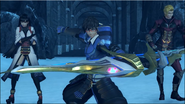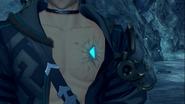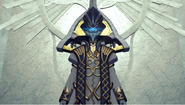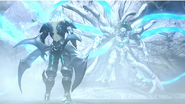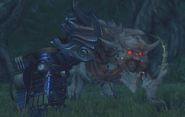
|
For those who have not completed games in the Xenoblade Chronicles series, this page contains spoilers regarding the plot. Discretion is advised. |
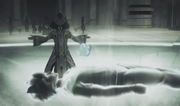
Amalthus creates a Blade Eater
Blade Eaters are entities similar to Flesh Eaters. They are humans who have been fused with at least part of a Blade's Core Crystal. Blades who have been eaten lack part of their Core Crystals, which usually split in a non-regular shape, as can be seen in Pandoria's or Fan la Norne's crystals.
Blade Eaters have a significantly longer lifespan than a regular human. Some Blade Eaters, like Mikhail, have lived for centuries, and are able to use their weapons as if they were Blades. Others, like Gort, end up as failed experiments, suffering numerous mutations that barely keep them alive.
Blade Eater technology was pioneered by the Indoline Praetorium as military weaponry. However, it has also be shown to have medical applications. Because this technology was unheard of before the end of the Aegis War, Mythra fails to identify the type of resonance between Blades who have been eaten and their Drivers. Blades which have been eaten cannot return to their Core Crystal upon incapacitation, and thus may die permanently.
In the world of Aionios in Xenoblade Chronicles 3, almost of all of the humans in Agnus have Core Crystals. Taion, in particular, is implied to be a Blade Eater as his Core Crystal is not stained red nor does he have any Blade-like traits.
Known Blade Eaters[]
Notes[]
- Despite being similar in concept to a Blade Eater due to having part of a Core Crystal in his body, Rex is never considered as one. Instead of obtaining unique abilities or a longer lifespan, both Rex and Pyra and Mythra became more vulnerable, sharing their injuries, with Pyra and Mythra themselves losing their immortality. Mythra explains that, when a Blade shares their Core Crystal with another, it splits in a uniform fashion, with the rule being that the center goes to the other, while the Blade remains with the outer part. As part of this split, the divided core parts exchange information between each other, reflected in both parties sharing their injuries, regardless of who originally suffered it. This exchange does not seem to happen between a Blade who has had (part of) their core stolen and the thief.
- Although not always the case, becoming a Blade Eater may grant the individual a second form such as for Amalthus.

